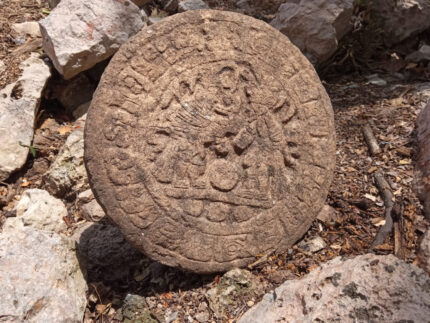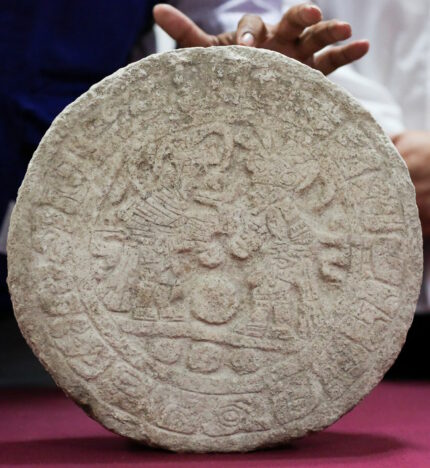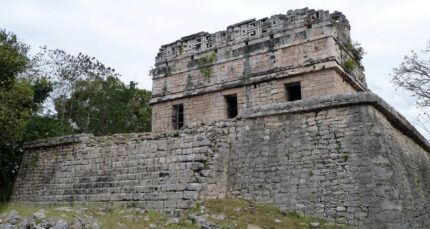 Archaeologists have discovered a disc-shaped stone marker from the Maya ball game at the archaeological site of Chichén Itzá in Yucatán, Mexico. It is intact and contains a complete hieroglyphic text, an extremely rare find in Chichén Itzá. The disc dates to the end of 9th century, only a couple of decades or so before the Mayan collapse and the demise of its writing system, making this inscription one of the last significant hieroglyphic texts about the ball game to survive.
Archaeologists have discovered a disc-shaped stone marker from the Maya ball game at the archaeological site of Chichén Itzá in Yucatán, Mexico. It is intact and contains a complete hieroglyphic text, an extremely rare find in Chichén Itzá. The disc dates to the end of 9th century, only a couple of decades or so before the Mayan collapse and the demise of its writing system, making this inscription one of the last significant hieroglyphic texts about the ball game to survive.
The marker is a circular piece of limestone 32.5 cm (12.8 inches) in diameter weighing 40 kilos (88 lbs). It is engraved with images of two Maya dignitaries playing the Mesoamerican ball game (Pok Ta Pok in the Mayan language) with the hieroglyphic inscription of 18 cartouches around the outer border. The hieroglyphics include a short count date that translates to 894 A.D.
 There are two figures in the center of the stone. The one on the left is wearing a feathered headdress and a flowered sash. The one on the right is wearing a snake turban and the protective equipment worn to play the game. A scroll hovers in front of the face of the left figure. This likely represents a voice or exhalation. The figures are players/officials engaged in a specific ritual or event related to the game.
There are two figures in the center of the stone. The one on the left is wearing a feathered headdress and a flowered sash. The one on the right is wearing a snake turban and the protective equipment worn to play the game. A scroll hovers in front of the face of the left figure. This likely represents a voice or exhalation. The figures are players/officials engaged in a specific ritual or event related to the game.
The marker was discovered within the architectural complex of the Chichanchob, also known as the Casa Colorada or Casa Roja after the remains of red paint on the interior vestibule, one of the best-preserved monumental structures in the city. It was constructed in the Terminal Classic period (ca. 800-920) in the Puuc architectural style, characterized by blank facades in the lower parts of buildings and intricately carved upper facades. Shortly after its construction, a small ball game court was added to the back wall of the structure.
 The disc was found upside-down less than two feet under the surface of the ground. It was probably part of the east wall of an access arch leading into the Casa Colorada complex. When the arch collapsed, the marker did too.
The disc was found upside-down less than two feet under the surface of the ground. It was probably part of the east wall of an access arch leading into the Casa Colorada complex. When the arch collapsed, the marker did too.
INAH conservators have begun a desalination process with cellulose fiber compresses. It is also being cleaned with distilled water. Researchers have also embarked on the photogrammetry technique, taking overlapping high-resolution images of the text and iconography to create a 3D model of the disc for detailed study and a full translation of the inscription.
demise of its writing system: The writing system was in place up until the conquest. The maya stopped carving stela at the end of the 900s as far as is known but writing on paper was still common enough.Maya writing was treated with extreme prejudice after the conquest and so was lost.
The new stone is a great discovery .